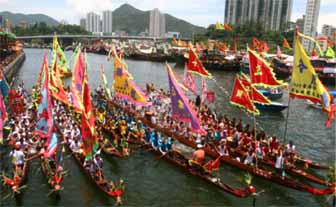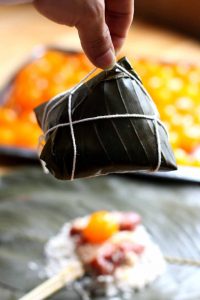
China’s Dragon Boat Festival or Duanwu (端午節) is celebrated on the fifth day of the fifth month of the lunar calendar, which falls on May 30 this year. It commemorates the death of Qu Yuan (屈原), a Chu state official and poet who lived during the Warring States Period (475-221 BC) before the reunification of China under the Qin Dynasty (221-206 BC). He was exiled after opposing his king’s decision to ally with the neighboring state of Qin, and when Chu was finally conquered by Qin, he committed suicide by drowning in the Miluo River (汨羅江) on the fifth day of the fifth lunar month, thus Dragon Boat Festival is also known as Double Fifth Festival.
The Chu people, who admired Qu Yuan for his loyalty and integrity, threw rice dumplings into the river to feed the fish so they would not eat the body of their poet hero. It is said people then started dragon boat racing to scare off the fish. It is one of the oldest festivals, not only in China but also throughout the world, with a history of more than 2,000 years.
In 2006, the traditional festival was listed as one of China’s national intangible cultural heritages. In 2008, it was recognized as a public holiday in Chinese mainland. People today hold boat races and prepare zongzi (粽子), the glutinous rice with stuffings wrapped in reed leaves made to honor the great poet, Qu Yuan. In the Philippines, it is better known as ma-chang (in Hokkien 肉粽).
You can make ma-chang at home, provided the materials required are available.

Savory rice ma-chang
Ingredients (makes 30)
2 kg glutinous rice, washed and soaked
500 g pork belly, cut into chunks
100 g pork fat, cubed
300 g dried chestnuts, soaked
50 g dried shrimps (hebi), soaked
50 g dried Chinese mushrooms, soaked and sliced
2 whole bulbs garlic, skinned and chopped
2 bundles 10 cm wide bamboo leaves, plus raffia/reeds to tie
15 salted egg yolks (optional), halved
Soy sauce, five-spice powder, salt and pepper to taste
Method:
1. Soak and clean bamboo leaves. Trim off hard stems and tips.
2. Soak the dried raffia so they become pliable. Gather into bunches of 10 strings and tie one end with a large knot.
3. Marinate pork belly with good quality soy sauce and five-spice powder, salt and pepper. Season meat generously since the long cooking process leaches the salt and dilutes the flavor.
4. Divide pork fat cubes into two portions. Marinate half with five-spice powder. Place the other half into a medium hot pan, and start rendering the fat. When you have about two tablespoons oil, add the chopped garlic and stir fry till garlic turns golden. Drain garlic. Set aside.
5. In remaining oil, fry the mushrooms till fragrant. Set aside. Add pork belly and fry in oil with a little garlic added. Add more soy sauce. Drain pork belly pieces and set aside.
6. Keep pan juices. Add more garlic into pan. Add the rice and stir well so that the grains are lightly colored. Remove from heat and place the rice in a big pot.
Wrapping the ma-chang:
1. Make a fold halfway in the bamboo leaf and bring the two halves together so a cone is created.
2. Hold the leaf by its two edges, add one tablespoon of rice. Add chestnut, mushroom, pork belly, salted egg yolk if using, some dried shrimps and a piece of five-spice marinated pork fat. Cover filling with more rice.
3. Cup the bamboo leaf. Use thumb and forefinger to shape it. Using your other hand, fold the leaf over the top, pressing down. This is the base of the pyramid.
4. Flip the cone over, and wrap the ends of the leaf around and about the rice cone.
5. Hold the completed cone firmly in one hand, use a raffia string and wrap around the sides, tie it up with a fisherman’s knot.
6. When you have completed 10 pieces in a bunch, suspend the ma-chang with a long handled wooden spoon over a large pot of boiling water for three to four hours. The ma-chang must have enough room to move around in the water so don’t cram in too many. Remember to top up with boiling water if the level falls low. Ma-chang must be covered completely. (Large ma-chang need longer cooking time).
7. When ma-chang are cooked, hang them up to dry off completely before storing them.
Food notes: Wrapping the ma-chang just needs practice. Basically, you are creating a cone in which to place the rice and filling. Even if you do not get a perfect pyramid, don’t worry. If you are really hopeless at manipulating the bamboo leaves and tying them up, here’s a cheat’s solution. Simply place layers of rice and meat filling into small metal or glass bowls and steam them over rapidly boiling water for about an hour. The resulting little round puddings will taste just as good. Other variations of ma-chang are the Chinese date zongzi, Cantonese mung bean zongzi, to name a few. You can also experiment with your own fillings. Here in the Philippines, some ma-chang have Chinese sausage in them. Enjoy your homemade ma-chang this Dragon Boat Festival. And if you’re Tsinoy, you eat ma-chang with tomato ketchup!
